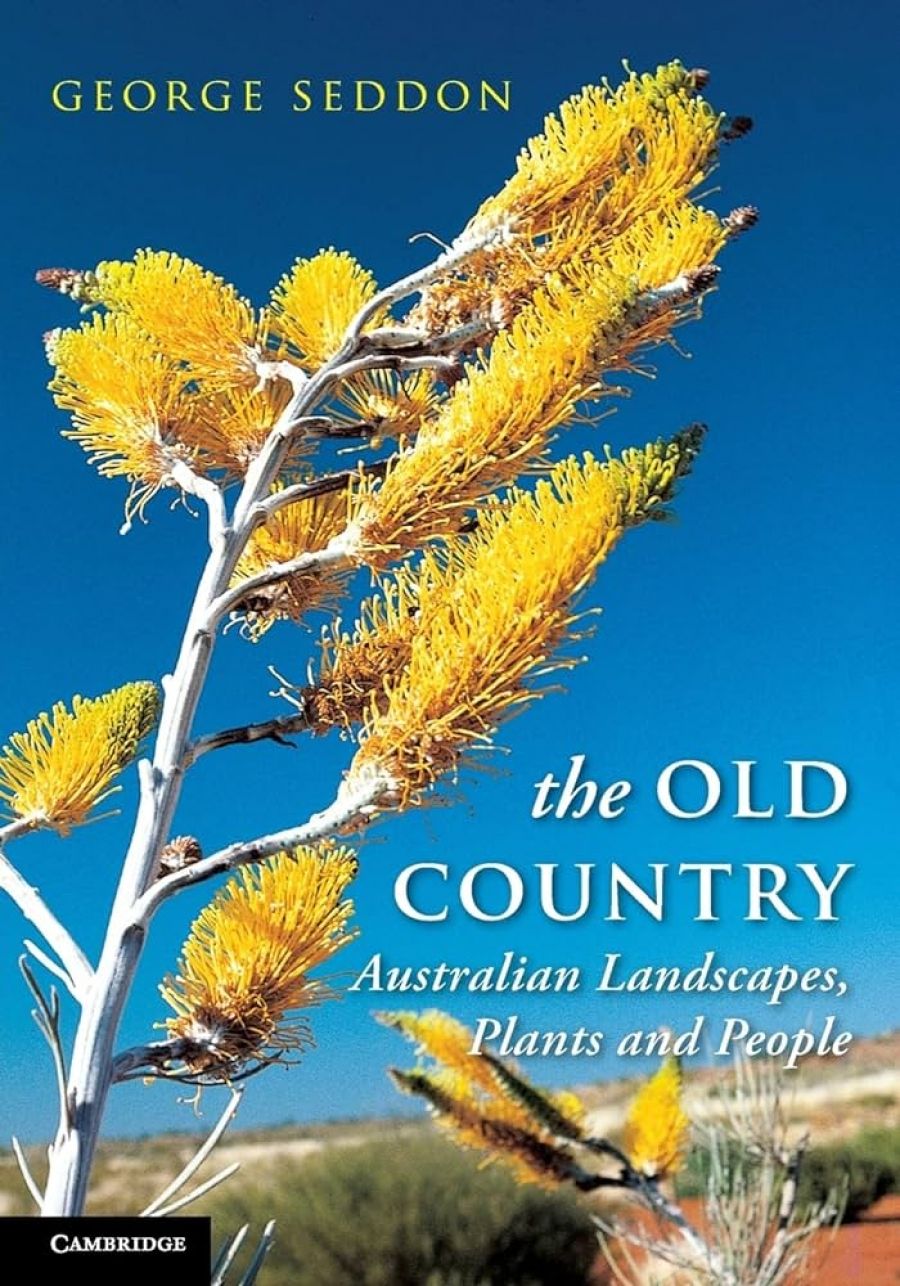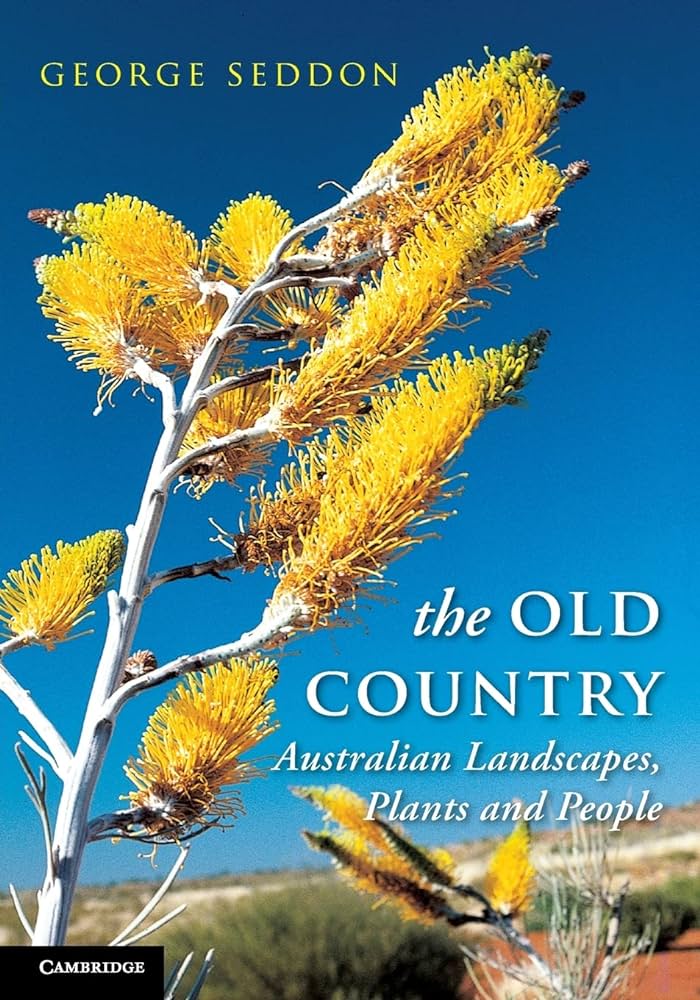
- Free Article: No
- Contents Category: Non-fiction
- Custom Article Title: Seddon's swansong
- Review Article: Yes
- Article Title: Seddon's swansong
- Online Only: No
- Custom Highlight Text:
The old country is, by his own admission, George Seddon’s last book. Last books are generally the products of two factors: posthumous recognition of work-in-progress, or a generous sharing of one lifetime’s accumulated wisdom. Happily, this book falls into the latter category. The opening chapter does nothing to jolt this impression; with avuncular ease, Seddon introduces his characters and stories. We sit with Uncle George at the fireside – or more realistically, given the irony of the title, around the campfire. The stream of consciousness is conversational, discursive and often intensely personal. Seddon has a gift for storytelling. While still in the roman numerals of the preface, we have a telling example: ‘The past lies at the author’s feet,’ Seddon observes epigrammatically, his boots juxtaposed over 3.5-billion-year-old stromatolites at Marble Bar in Western Australia’s far north-west. We immediately under-stand that the author’s time frame is very wide indeed. We were half expecting a gardening book – or at least a book about plants, judging from its Dewey classification – but should not be surprised by this un-conventional opening gambit. ‘We live in old landscapes with limited water and soils of low fertility,’ Seddon explains, ‘yet with a rich flora that is adapted to these conditions, as we are not. There is much to learn from it, but we have been slow learners.’
- Book 1 Title: The Old Country
- Book 1 Subtitle: Australian landscapes, plants and people
- Book 1 Biblio: CUP, $49.95 hb, 270 pp
- Book 1 Cover Small (400 x 600):

- Book 1 Cover (800 x 1200):

Seddon marshals his material in The Old Country into nine ‘exploratory essays’ of increasing complexity. In ‘First Encounters’, we meet Dutch and French explorers of the seventeenth century and, more particularly, the English adventurer William Dampier. Active in the 1690s, Dampier was amongst the earliest-known European plant collectors to touch on Australian shores. In succeeding chapters, the focus is tightened onto plants themselves, covering a wide spectrum of encounters with the Australian environment: the boab tree, Australian conifers and the genus Banksia. Interspersed is a chapter simply entitled ‘Learning’, which explores the relationships between Aboriginal and European knowledge systems as they relate to plants and their use. Combinations of plants and their characteristics dominate the last four chapters, namely the supposed ‘Mediterraneity’ of some Australian regions, ‘On Being Deciduous’, landscape design and weeds.
Seddon’s observations are complemented – often to great effect – with striking colour photographs by Colin Totterdell. For the sake of cohesion, one regrets that Totterdell’s work was not featured exclusively. Occasional archival images add richness to our understanding of the subject, but I yearned for the inclusion of two or three maps in which to locate the action. The standard of production is high, but this only serves to highlight several editorial shortcomings. The bibliography is wide ranging, yet referencing is sketchy, especially coming from the press of a university that would not tolerate such inconsistency from its students. Some of the prose is heavy going (the chapter on conifers, for instance) or fragmentary (banksias), at odds with the easy flow found elsewhere. And there are some odd editorial lapses: the use of the term ‘nurserymen’ in a section devoted to female achievement. But as I have observed above, Seddon is at his best when imparting knowledge drawn from his considerable personal experience, and this generously suffuses the book.
The choice of discrete yet thematically linked essays is one that has all too infrequently been adopted for books on Australian plants and their use in landscape design. One thinks of Thomas Shepherd’s two sets of essays on Australian horticulture and landscape gardening (1835–36), C. Bogue-Luffmann’s Principles of Gardening for Australia (1903), Edna Walling’s Gardens in Australia (1943), and Alistair Knox’s Living in the Environment (1975). Each has been the product of a singular mind and the expression of a key moment in Australian garden history. The Old Country is a worthy successor. Seddon ranges across broad territory, backwards and forwards, here marvelling over a microscopic detail, and there broadening our knowledge of its context. Almost always this is done with candour and insight. Whereas most of us can appreciate history in decades and centuries, Seddon is at ease over millennia. His polymathic interests – geology, literature, education, gardening and environmental science – ensure that The Old Country comes alive for the reader, regardless of prior knowledge or engagement with the subject. Although terms such as ‘autochthonous’ and ‘dipterocarp’ will be familiar only to the specialist, these are infrequent and rarely disturb the flow.
Let one example of Seddon’s style suffice: his observations linking Madagascar and Australia. To some an unlikely combination, Seddon observes that ‘Islands are the laboratories for the study of evolutionary patterns’, then uses the boab tree as his case study. We are disarmed by Seddon’s roadside snap of his arboreal prey and then engaged in speculation about the evolutionary possibilities of this genus, and of time frames that govern our notions of indigeneity. Do thirty million years qualify, or would we prefer the full Jurassic millions since the supercontinent Gondwana broke from its parent, Pangaea?
Seddon then hypothesises about the implications of French or Dutch colonisation of Australia: the Kimberley as an independent république, or even a département of France with Paris as its capital, or Dutch-speaking Perth with King’s Park (Konings Parc) reconstituted as de Vlamingh Botanische Tuin, honouring its seventeenth-century founder. How would boab trees fare in each of these scenarios? With consummate ease, we are drawn into a wide-ranging discussion as a prelude to one of Seddon’s key themes: what criteria should we use to guide plant selection for Australian garden making through the challenges of the twenty-first century and beyond?
While acknowledging the freedom of choice Australian gardeners enjoy, Seddon lists four basic constraints and responsibilities for plant choice: species that can survive on the natural rainfall, with limited supplementary watering; will flourish without the addition of chemical fertilisers; are not likely to became invasive, as garden escapes; and provide food and habitat for the indigenous bird populations.
At a more subtle and subjective level, Seddon lists five additional aesthetic criteria: beauty of flowers, foliage, bark, form and relation to context. Seddon then tests a current fav-ourite, the European olive, and concludes that, whilst it meets most of his criteria, its invasive qualities would rule it out for most Australian gardens. There are many other issues at stake, and all receive thoughtful discussion. ‘Reticulation has destroyed that once obligatory frugality,’ Seddon laments while discussing water usage, pointing to dramatic shifts necessary as we continue to pursue wet dreams for our dry continent.
Seddon sets a tough assignment, perhaps one that will be too prescriptive for most Australian gardeners. He gives two examples that exemplify the new style: Fiona Brockhoff’s garden Karkalla on Victoria’s Mornington Peninsula, and the suburban Perth garden of Robert Powell and Jane Emberton. Both gardens are well known to their constituency, but this is as yet a limited one, far removed from the mass of Australian gardeners. As if to underscore the enormity of the task, Seddon lists ‘Some reasons for making exceptions’ in his chapter on landscape design. Freedom of individual choice, the planting of deciduous trees, and limited inclusion of non-Australian species are given as exceptions. Choice oils the wheels of commerce; challenge provokes and promotes thoughtful design. Like many other cultural mindsets in contemporary Australia, reconciling these extremes will require wisdom and perhaps generational change.


Comments powered by CComment